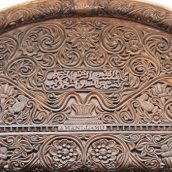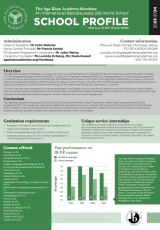Swahili Culture Influences Year 10 Art Project
 The Aga Khan Academy, Mombasa takes pride in its community of learners within the walls of the campus, but opportunities for inspiration can be found everywhere. An example of this is the Year 10s’ art trip to Old Town in Mombasa on Friday, 21 November 2014 to learn more about Swahili doors.
The Aga Khan Academy, Mombasa takes pride in its community of learners within the walls of the campus, but opportunities for inspiration can be found everywhere. An example of this is the Year 10s’ art trip to Old Town in Mombasa on Friday, 21 November 2014 to learn more about Swahili doors.
The doors are seen as a quintessential symbol of Mombasa and Swahili culture in general, but the trip revealed that the deceptively simple architecture has layers of history and tradition. As explained by their guide, Mr. Mohammed, Swahili culture borrows a lot of different influences from Portuguese, Indian and Arabic cultures. This in turn is reflected in the doors of Swahili households.
“You can see the lotus flower, which is very symbolic of Hinduism and, more specifically, Krishna,” explains Robin Murphy, a Year 10 art student. “But then you also see a lot of Arabic carving along the doors, most of which were prayers to protect the household, influenced by the Arab culture.”Other symbolism includes the spikes and chains sometimes found on the doors, which were not only a security feature, but were also used to scare off scavengers or symbolize the links and unity in a family. Five columns carved into the woodwork were also seen very often, representing the five pillars of Islam.
 The trip has also made the students more aware of the influences of Swahili culture around the Academy campus, such as the lotus flower motifs in the wall vents, the sun imagery around the railings of balconies, and the lattice design largely featured in the Commons and residential buildings.
The trip has also made the students more aware of the influences of Swahili culture around the Academy campus, such as the lotus flower motifs in the wall vents, the sun imagery around the railings of balconies, and the lattice design largely featured in the Commons and residential buildings.
The students are now expected to use their knowledge to inspire their own ‘Swahili door’, with symbolism to bring out their own unique personalities. We look forward to seeing some spectacular work from the Year 10s, and hope they keep using their surroundings to inspire themselves.






